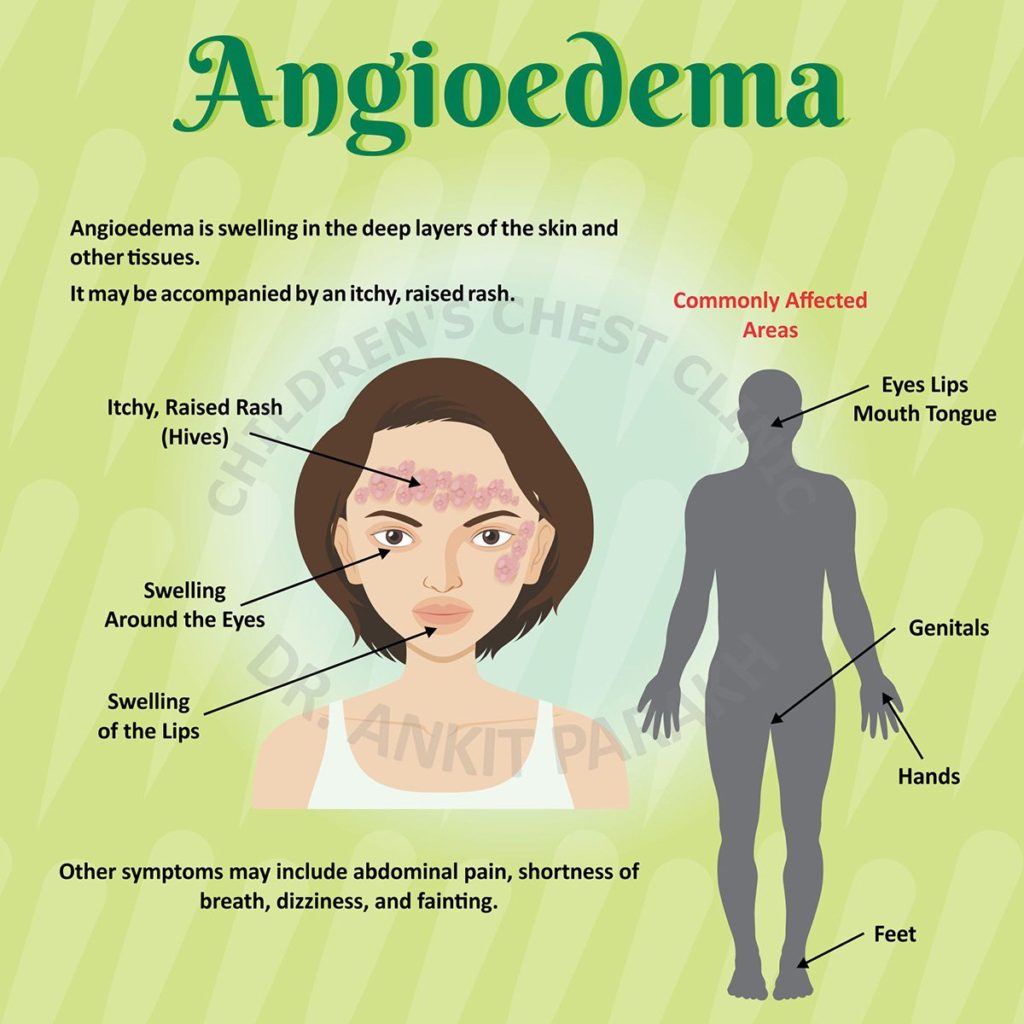Causes, Symptoms, and Treatment
Angioedema is a condition that causes swelling beneath the skin’s surface and can affect any part of the body. It can range from mild to severe and can be life-threatening in some cases. In this article, we will discuss the causes, symptoms, and treatment of angioedema.
Table of Contents
- What is Angioedema?
- Types of Angioedema
- Causes of Angioedema
- Symptoms of Angioedema
- Diagnosis of Angioedema
- Treatment of Angioedema
- Medications for Angioedema
- Lifestyle Changes for Angioedema
- Prevention of Angioedema
- Complications of Angioedema
- When to See a Doctor for Angioedema
- Prognosis of Angioedema
- Conclusion
- FAQs
1. What is Angioedema?
Angioedema is a medical condition that causes rapid swelling beneath the skin’s surface. The swelling usually occurs in the face, lips, tongue, throat, and genitals. Angioedema can affect any part of the body, including the hands, feet, and internal organs.
2. Types of Angioedema
There are several types of angioedema, including:
- Allergic angioedema: Caused by an allergic reaction to food, medication, insect bites, or other allergens.
- Idiopathic angioedema: No known cause, often referred to as chronic spontaneous urticaria with angioedema
- Hereditary angioedema (HAE): Caused by a genetic defect that affects the production of a protein called C1 inhibitor.
- Acquired angioedema: Caused by an underlying medical condition, such as an autoimmune disease or a lymphoproliferative disorder.
3. Causes of Angioedema
Angioedema can be caused by a variety of factors, including:
- Allergic reactions: Food, medication, insect bites, or other allergens can cause angioedema.
- Medications: Some medications, such as ACE inhibitors, can cause angioedema.
- Genetics: Hereditary angioedema is caused by a genetic defect that affects the production of a protein called a C1 inhibitor.
- Underlying medical conditions: Autoimmune disease or lymphoproliferative disorder can cause acquired angioedema.
4. Symptoms of Angioedema
Symptoms of angioedema include:
- Swelling beneath the skin’s surface
- Itching or burning sensation
- Redness or discoloration
- Pain or discomfort
- Swelling of the eyes, lips, tongue, throat, or genitals
- Difficulty breathing or swallowing
5. Diagnosis of Angioedema
Diagnosis of angioedema is typically based on the patient’s medical history, physical examination, and allergy testing. In some cases, additional tests may be needed, such as blood tests or skin biopsies.
6. Treatment of Angioedema
The treatment of angioedema depends on the underlying cause and severity of the symptoms. Treatment options may include:
7. Medications for Angioedema
- Antihistamines: Used to treat allergic angioedema.
- Corticosteroids: Used to reduce inflammation and swelling.
- Epinephrine: Used in severe cases of angioedema to open airways and reduce swelling.
- C1 inhibitor replacement therapy: Used to treat hereditary angioedema.
8. Lifestyle Changes for Angioedema
In addition to medications, some lifestyle changes can help manage angioedema. These include:
- Avoiding triggers: If you know what triggers your angioedema, avoiding these triggers can help prevent symptoms.
- Avoiding nonsteroidal anti-inflammatory drugs (NSAIDs): These medications can worsen symptoms of angioedema in some people.
- Wearing protective clothing: If you are at risk of insect bites or stings, wearing protective clothing can help prevent symptoms.
9. Prevention of Angioedema
While it may not be possible to prevent all cases of angioedema, there are some steps you can take to reduce your risk. These include:
- Avoiding known allergens: If you have a known allergy that triggers angioedema, avoiding these allergens can help prevent symptoms.
- Taking medications as directed: If you take medications that can cause angioedema, taking them as directed can help reduce your risk of symptoms.
- Seeking medical attention: If you experience symptoms of angioedema, seeking medical attention promptly can help prevent complications.
10. Complications of Angioedema
In some cases, angioedema can lead to complications such as:
- Swelling of the throat, can obstruct the airway and cause difficulty breathing.
- Anaphylaxis, is a severe allergic reaction that can be life-threatening.
11. When to See a Doctor for Angioedema
If you experience symptoms of angioedema, it is important to seek medical attention promptly. This is especially important if you experience symptoms of anaphylaxis, such as difficulty breathing, rapid heartbeat, or a sudden drop in blood pressure.
12. Prognosis of Angioedema
The prognosis of angioedema depends on the underlying cause and severity of the symptoms. In most cases, symptoms can be managed effectively with medications and lifestyle changes. However, severe cases of angioedema can be life-threatening if not treated promptly.
13. Conclusion
Angioedema is a medical condition that causes swelling beneath the skin’s surface and can be caused by a variety of factors, including allergies, medications, and underlying medical conditions. While it can range from mild to severe, most cases can be managed effectively with medications and lifestyle changes.
14. FAQs
- Can angioedema be cured?
- There is no cure for angioedema, but symptoms can be managed effectively with medications and lifestyle changes.
- What is the difference between angioedema and hives?
- Hives are raised, red, itchy bumps that appear on the skin’s surface, while angioedema causes swelling beneath the skin’s surface.
- Can stress cause angioedema?
- Stress can trigger angioedema in some people, but it is not a direct cause.
- Is angioedema hereditary?
- Hereditary angioedema is caused by a genetic defect and can be inherited from a parent.
- Can angioedema be life-threatening?
- Severe cases of angioedema can be life-threatening if not treated promptly, especially if they lead to swelling of the throat and difficulty breathing.
DISCLAIMER:
This information is not presented by a medical practitioner and is for educational and informational purposes only. The content is not intended to be a substitute for professional medical advice, diagnosis, or treatment. Always seek the advice of your physician or other qualified healthcare providers with any questions you may have regarding a medical condition. Never disregard professional medical advice or delay in seeking it because of something you have read.
Since natural and/or dietary supplements are not FDA-approved they must be accompanied by a two-part disclaimer on the product label: that the statement has not been evaluated by FDA and that the product is not intended to “diagnose, treat, cure or prevent any disease.”





